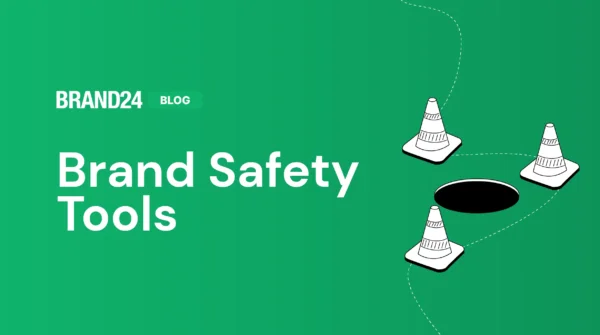How to Measure Brand Health & 8 Key Metrics to Track
Table of contents
A brand health check will help you determine the current state of your company and implement necessary improvements. It tells you whether your brand is OK or not. Measuring brand health on a regular basis will help you stay one step ahead of your competitors.
The insights gathered during the process will help you provide value to your customers and improve the general perception of your brand. Also, you will detect whether anything affected brand health.
Take a look at our short guide:
- What is brand health?
- Why should you measure brand health?
- How to measure brand health?
- Key brand health metrics
- How to improve brand health?
- Conclusion
What is brand health? Definition
Brand health measures how effective your brand is in helping you achieve your business goals.
While measuring brand health, you should take into account different aspects of your brand presence, for example:
- Brand awareness
- Brand reputation
- Brand equity
- Employee engagement
- Brand consideration
Tracking all the metrics listed above will help you get the full picture of your brand’s health.
Of course, you don’t have to incorporate every metric into your analysis. Choose the right aspects of the analysis that will benefit your brand the most.
Use the social listening tool to measure and track your brand health.
Why should you measure brand health?
A healthy brand is one of the most important assets you can have.
Your brand can help you achieve your business goals. A strong and healthy brand will help you find new customers, increase brand awareness, and even improve your customer experience.
It sounds too good to be true, doesn’t it? Well, it’s not.
There are millions of reasons why customers choose one brand over another. Among the key factors that influence customer behavior are:
- Friends and family recommendations,
- Cooperations with influencers,
- Online reviews,
- Brand reputation,
- Brand awareness,
- Employee engagement,
- Brand positioning.
And guess what – the last four points are strictly related to brand health.
This means you have a lot of say when it comes to influencing your potential customers and winning them over.
A healthy brand is important as it can be one of the most crucial factors that will differentiate you from your competitors.
The market is very saturated and sometimes it’s hard to compete with other companies. A strong and healthy brand can be your hallmark that will help you win over customers.
Why is it important to look at the big picture?
When it comes to brand health, every aspect of brand performance is important. Getting a holistic view will help you identify your strengths and weaknesses and develop an all-encompassing brand strategy.
If you consider all the factors, like brand reputation, customer experience, or brand awareness, you can spot the negative aspects you should improve.
For example, if you take a deeper look at your social media strategy, you can see that your brand can generate a lot of buzz on social media, but if the prevailing sentiment is negative, this obviously isn’t good for business.
If you measure all the factors together, you will get a comprehensive view of your brand’s health.
To make matters simple you can set three grades your brand can achieve:
- Healthy brand – you should focus on keeping things going for you as they are, or look for innovations to become an industry leader;
- A just–fine brand – you should develop a set of improvements you can incorporate into your business;
- Unhealthy brand – your brand is damaging your business and you need to act swiftly to improve the situation.
Use the social listening tool to measure and track your brand health.
How to measure brand health?
To measure brand health, you’ll need a media monitoring tool, for example, Brand24, Buffer’s top social listening tool.
The tool will start gathering and analyzing all the publicly available mentions across news, blogs, forums, newsletters, podcasts, and social media such as Instagram, Twitter, Facebook, Youtube, TikTok, Telegram, and Twitch.
Brand24 collects publicly available online mentions containing your predefined keyword. The tool is compliant with all strict Facebook regulations and the GDPR.
If you want to measure your brand’s health, enter the keywords strictly related to your brand, for example:
- Brand name
- Your branded hashtags
- The name of your product or service
- The unique hashtag you add to your social media posts
Key brand health metrics
To correctly assess the health of your brand, you need to look at specific brand trackers.
Tracking important brand health metrics will help you identify your strengths and weaknesses. And ultimately, will help you boost your overall business performance.
So, what do you need to measure to assess your brand health?
- Brand awareness
- Brand reputation
- Employee engagement
- Brand positioning
- The share of voice
- Returning visitors
- Search intent
- Time on website
01 Brand awareness
Brand awareness will tell you how familiar consumers are with the qualities or image of your brand. The best way to measure brand recall is to use a social listening tool.
A healthy brand will have not only high brand awareness levels but also the buzz it generates will be mainly positive.
Brand24 analyses all the mentions that contain your predefined keywords. It will also analyze the buzz and show you:
- The total number of mentions,
- Social media reach – an estimate of how many people stumble upon your message on social media,
- The sentiment – the number of positive and negative mentions about your brand.

If you’d rather analyze the mentions one by one, take a look at the Mentions tab.
Thanks to filters you can analyze only positive or negative records, and filter them by the number of interactions, or a specific domain.
Presence Score is one of the most valuable brand awareness metrics. It is a metric developed by Brand24. It will help you to understand awareness of your brand, competitors, or topics of your interest.

Discover the Presence Score of your brand.
02 Brand reputation
Brand reputation measures how your brand is viewed by others.
Consumers will trust a brand with a good reputation. And there’s no better way to build a positive brand reputation than by providing your customers with exquisite customer service.
What does it mean exactly?
Great customer service will help your clients quickly and in a friendly way.
Customer service is one of the most important aspects of a brand’s reputation. Your customers will appreciate a helpful customer success team, and it might be the decisive factor in their buying process.
Since time is of the essence, an Internet monitoring tool is an indispensable help.
Brand24 will show the mentions from the Internet, including posts where your Facebook fan page was tagged and Facebook reviews.
Monitoring social media networks and spotting mentions about your brand can help you avert a social media crisis.
By answering quickly to your customers’ queries you ensure not only a boost in your brand reputation, but you’ll also be able to decline your churn rate.
Happy customers stay with a brand longer and spend much more money. It’s a game worth playing.
To measure brand reputation, you can use Reputation Score metrics inside the Brand24 tool.

Discover the Reputation Score of your brand.
03 Employee engagement
That’s one of the most difficult aspects of a brand health check.
This brand health metric will tell you how passionate your employees are about their job.
In other words, it all comes down to your leadership skills. Can you inspire people so they are committed to their job and your organization?
A high employee engagement results in higher ROI, more efficient organization, and higher work culture.
How do you achieve high employee engagement?
It starts with the right recruitment process, followed by a clear mission statement. For many millennials, salary isn’t the most important factor when choosing a job.
Things like positive impact on the environment, and helping others are equally important.
You don’t have to look for a cure for one of the civilization’s diseases, but your company can actively take care of the environment by looking at some cutting-edge technologies.
Even something so simple as using energy-saving light bulbs can be a good starting point for creating an employee engagement culture.
Another point worth mentioning is creating a space where your employees can easily share their ideas and criticism. It might be hard to hear what’s wrong with your company, but it’s essential for your growth.
And your employees will surely appreciate that their voice is being heard.
04 Brand positioning
Brand positioning is a process of positioning your brand in the mind of customers.
To put it simply, you have to find a niche in the market for your brand and try to be a leader in it. There are various strategies when it comes to brand positioning. Your brand can be unique when it comes to pricing, promotions, packaging, customer service, distribution, and much more!
How to choose your brand’s niche? The easiest way will be to compare your brand to your competitors and try to beat them in one of their key positioning points.
For example, a brand positioning statement for Amazon says:
Unlike traditional book retailers, Amazon.com provides a combination of extraordinary convenience, low prices, and comprehensive selection.
As you can see, the key is to choose your brand positioning niche and then develop successful strategies to compete with others, be it much lower prices or exquisite customer service.
05 The share of voice
And last but not least — the share of voice. This metric will tell you what part of the overall online discussion was initiated by a certain social media profile.
The higher the share of voice, the more popular your brand is among its target audience. That means you are preparing content your audience wants to interact with.
It can also indicate that your branding strategy is working — your brand is something people talk about online.

Use the social listening tool to measure and track your brand health.
06 Returning visitors
Returning visitors is the metric that measures how often people come back to a website after their first visit. If a website has a high number of returning visitors, it is a sign that your brand is healthy and has strong brand loyalty.
People revisiting websites are more likely to become loyal customers with purchase intent. Furthermore, they might return because you fulfilled the brand promise, so they trust you.
Be sure to keep an eye on your return visitor numbers. You can check it using Google Analytics or Heap Analytics.
07 Search intent
What keywords and phrases do users type while searching for your brand? Are they accurate? If yes, that’s a brand’s success.
Search intent is a metric you can use to evaluate the effectiveness of a brand’s online search presence.
A brand with strong search intent will have a high degree of relevance for its target audience, appearing in search results for the terms and keywords that are most important to them.
In contrast, a brand with weak search intent may appear in few or no results for relevant terms, or it may appear in results that are not relevant to the user’s needs.
There are many keyword monitoring tools that can help you measure search intent.
08 Time on the website
Time on website metric tells you how long people stay on your website, on average. It’s a good indicator of engagement and interest.
If people spend a lot of time on your website, it’s a good sign that they’re interested in your brand. They find the content valuable and relevant.
If they’re only spending a few seconds, it could signify that they’re not finding what they’re looking for.
How to improve brand health?
Once you know how to conduct a brand health check, it’s time to see what to do when you are not satisfied with the results. How to increase brand recall, brand equity, and reach your target audience?
The solution is simple — social listening. With the help of a social listening tool, you can spot any questions your existing and potential customers might have and answer them right away.
01 Monitor the number of mentions around your brand and social media sentiment
A great way to do it is by looking at the Summary tab in Brand24. It will not only show you the number of results, social media reach, and positive and negative mentions but also show the difference between the two time periods.

Sentiment analysis will help you determine whether your brand message resonates well with your audience.
A spike in negative mentions should set off an alarm and encourage you to investigate the matter.
02 Spot customers’ complaints early and solve their problems
It doesn’t matter what business you run. Your customers should occupy a central spot.
Showing that you care about their problems will ensure that your clients will return and spread the good word about your business. Word-of-mouth marketing is the most powerful form of marketing there is.
Receiving a negative review or customer complaint is not the end of the world. In fact, it might even be good for your business. People tend not to trust products or services with perfect scores.
The key to success is to respond swiftly to a complaint. Brand24 offers three possible solutions to this problem:
- A Slack integration – you can connect your Brand24 project with a dedicated Slack channel and receive a notification every time there’s a new mention,
- An email alert – every time there’s a new mention, you’ll receive an email. In the Project Settings, you can set up a filter to only receive notifications with negative sentiment,
- An in-app notification – Brand24 offers a mobile app, both for Android and iOS, so you always have access to your projects.
03 Analyze customer feedback
Besides customer complaints, you’ll probably spot a lot of customer feedback in your brand tracking project.
Customer feedback is usually really hard to get, so it’s extra important to spot your customers’ suggestions. Negative mentions can badly affect brand health.

It will give you a hint in which direction you should develop your product. The features you think are important might be completely irrelevant to your customers.
04 Organize focus groups and surveys
That’s a bit tricky point. First of all, focus groups are quite expensive to organize. Surveys, on the other hand, are time-consuming for their users.
You can ask your customers to fill out an online survey by offering a discount code or a specially prepared piece of content.
Although focus groups are expensive, you’ll receive very in-depth qualitative data that will reveal a lot about brand health. Not only will you know how your brand is perceived today, but you’ll be able to spot how it has changed over time.
05 Run a brand awareness campaign
Brand health metrics rely strongly on the number of people familiar with your brand. The more people talk about your company or product, the higher your brand awareness levels.
Presenting your product to a new group of people will help you spot any weaknesses your brand or product might have. Improving them will ultimately help improve your brand health. There are some great brand awareness tools that can support you.
Use the social listening tool to measure and track your brand health.
Conclusion
Measuring brand health is an important part of understanding how well your company is doing and where it needs to improve. The key metrics I’ve outlined are a great place to start.
Key takeaways:
- The healthy brand delivers consistent customer inflow.
- Poor brand health might cause a brand recall.
- Negative mentions can badly impact your brand’s health.
- To track brand health you need to measure key metrics such as brand awareness and reputation, sentiment, the share of voice, returning visitors, or time on the website.
- To effectively build a strong brand you need a media monitoring tool.
Ready to start tracking brand health? Try the Brand24 tool for free!
FAQ
What is a brand health study?
A brand health study is a research-based assessment of a brand’s overall health and performance. This type of study is conducted to evaluate a brand’s strengths and weaknesses, assess the perception of the brand among the target audience, and identify areas for improvement. A brand health study typically involves collecting data on key brand metrics such as brand awareness, brand perception, brand loyalty, and brand preference. The results of the study can help businesses make informed decisions about their marketing and branding strategies, and take steps to improve their own brand health.
Is it brand health or brand equity?
Brand health refers to the overall status of a brand, including its perception and reputation among the target audience, as well as its performance in the marketplace. A brand health study is a research-based assessment of a brand’s current status and performance.
On the other hand, brand equity refers to the value of a brand, which is derived from the positive perception and associations that consumers have with the brand. A brand with strong brand equity is likely to have higher brand loyalty, greater pricing power, and increased market share.
While both concepts are important for assessing a brand’s success and potential, brand health focuses on the current status and performance of the brand, while brand equity focuses on the long-term value of the brand.
Related articles

![How to Conduct a Brand Audit? The 5 Step Guide [2025]](https://brand24.com/blog/app/uploads/2022/01/How-to-Conduct-a-Brand-Audit-_052022.png)
![Guide to Brand Monitoring + TOOLS [2025 update]](https://brand24.com/blog/app/uploads/2019/08/Top-10-brand-monitoring-tools.png)




